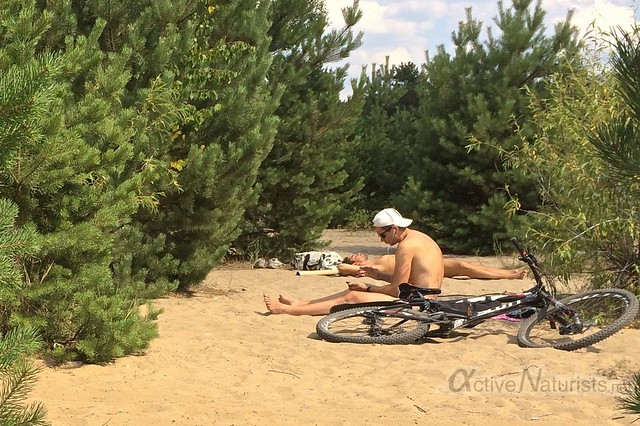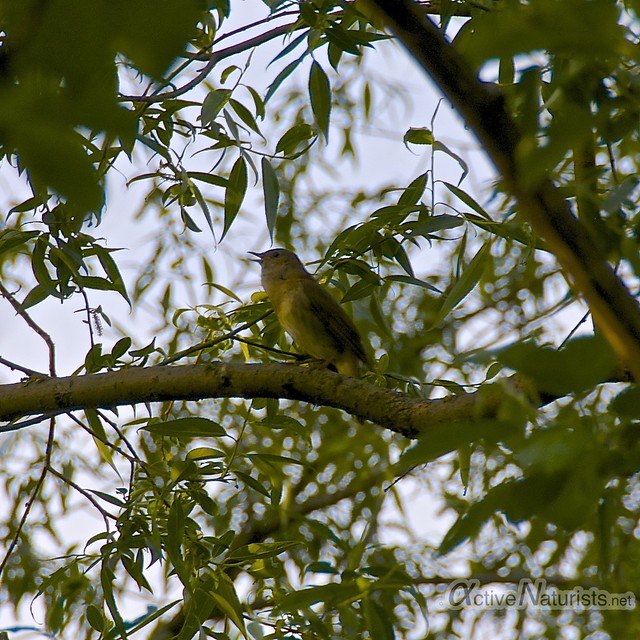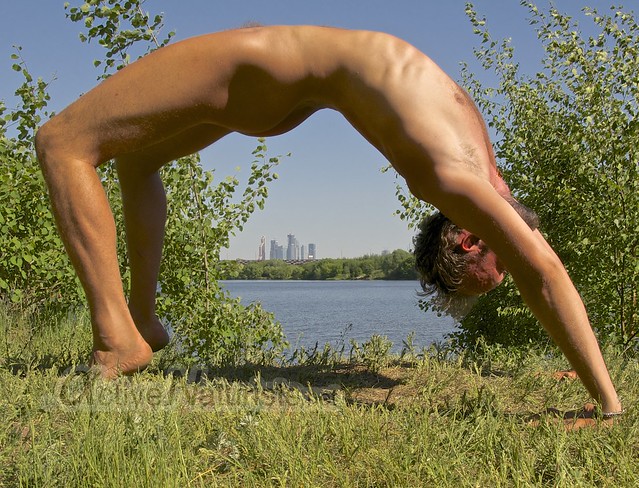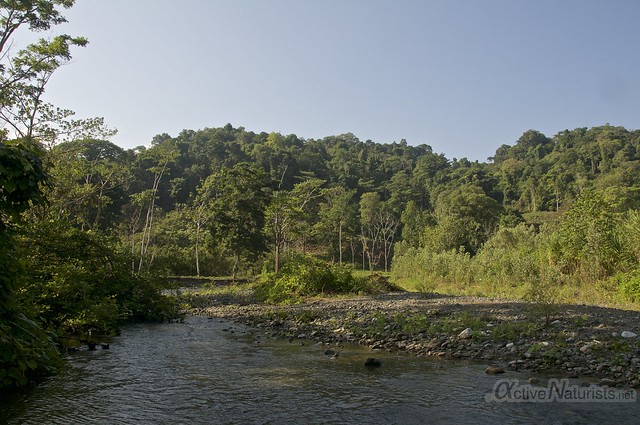
In the previous blogpost from Costa Rica, we teased you with a prospect of a naturalist report, so here it is: we had quite a remarkable expedition in one the most biodiverse locations in the world! And well, you guessed it – most of this trek was done by me (and to a less extent by my friends) in the buff – so once again, we were mixing naturism with big interest in natural history.
Costa Rica is a favorite for nature enthusiasts, with the highest percentage of protected land in the world; but even by Costa Rican standards, Corcovado National Park on the Osa Peninsula is very special. There are simply not many places left in the world where tropical rainforest meets the sea, and this park conserves the largest primary forest on the American Pacific coastline. For better or worse, visiting this park is highly regulated, e.g., it is forbidden to visit without a certified guide. The good thing is that the number of tourists is maintained at low levels, so there is no risk of overuse, but this makes it expensive and dependent on finding a guide. In our case, this guide also had to be OK with the idea of free-hiking, i.e. hiking without clothes. We were lucky to find one (through CouchSurfing) – both open-minded and knowledgeable about local wildlife. If you want to have a similar adventure, we highly recommend Elias (you can contact him via WhatsApp +50683811556).
So, we could enjoy this amazing natural habitat in the most natural attire,
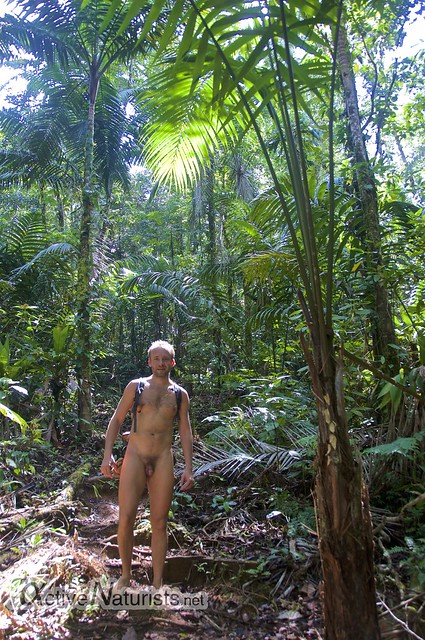
but thanks to our guide we could also see a lot of wildlife that would otherwise be nearly impossible to spot – like this Dendrophidion snake.
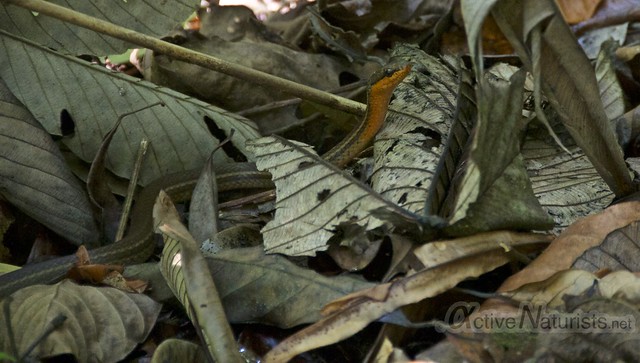
‘Hot lips’ of Psychotria elata plant were much easier to notice, and they seemed like a nice greeting in the beginning of the trail from Los Patos to Sirena station.
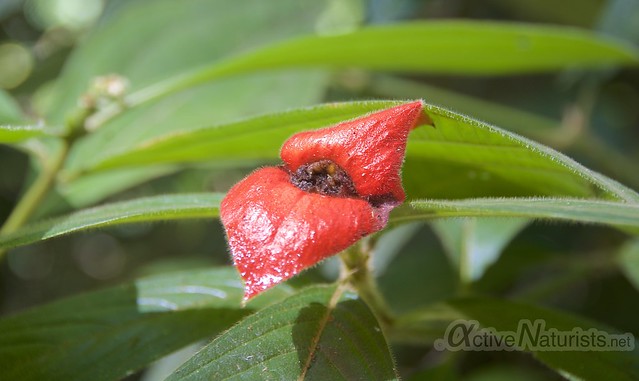
The forest was dominated by massive trees,
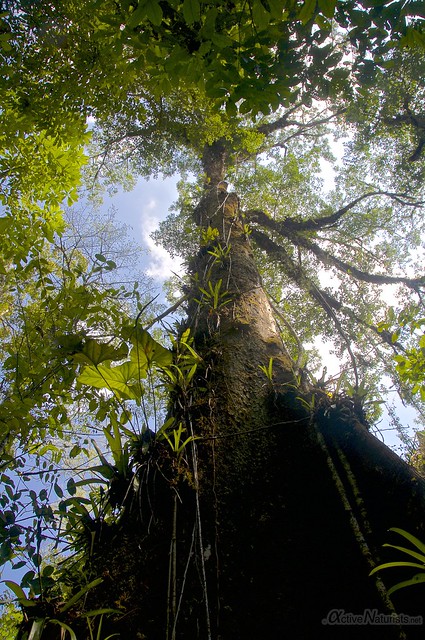
but during the first hour or so, there was also dense vegetation around the trail.
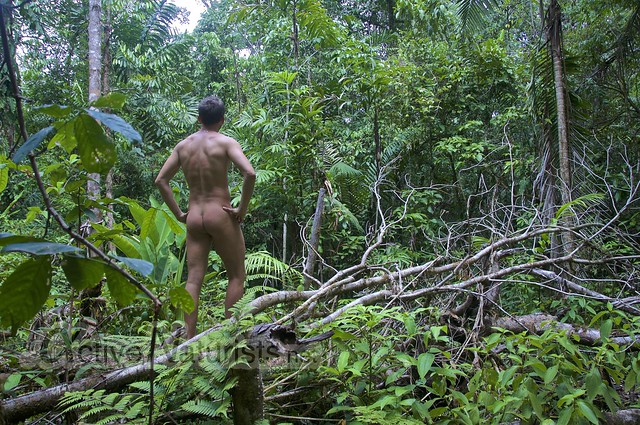
One has to be careful not to touch tree trunks and branches without looking at them, as they may be covered in spines,
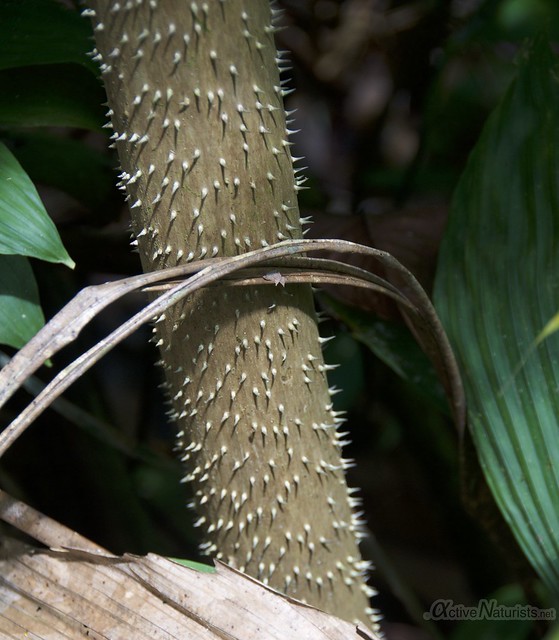
and some look just vicious!
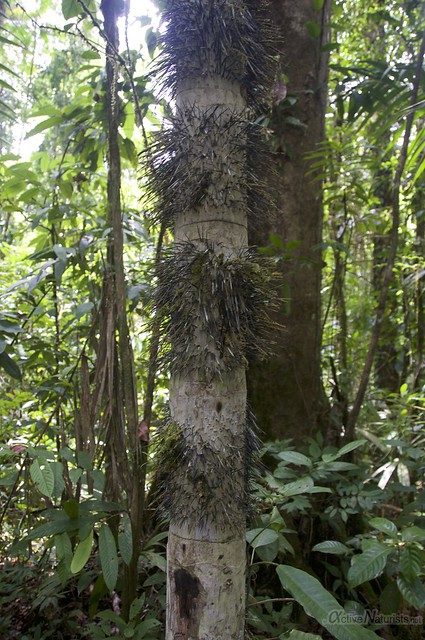
The first bird on the trail was crested guan (actually 3 of them).
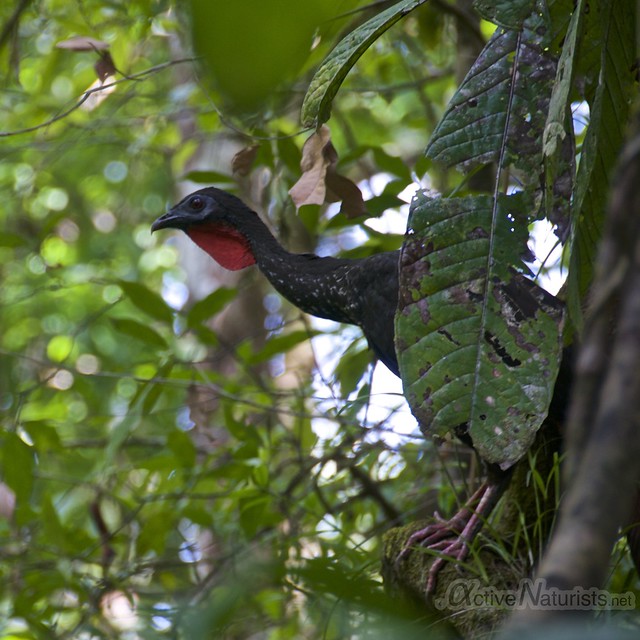
Our guide didn’t seem too excited to see them, as they must be very common, but to me even this relative of turkey seemed like a good start for birdwatching (and guan is quite different from the turkeys we see in North America).
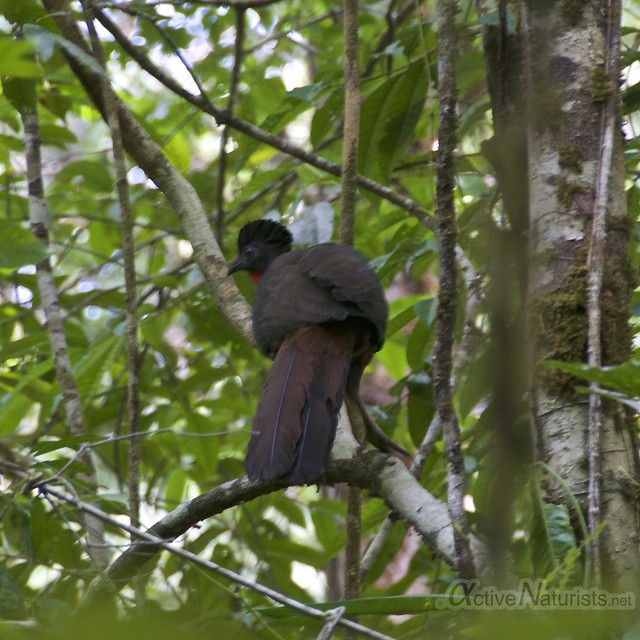
The first section of the trail after Los Patos is quite hilly, so I was certainly glad to walk without clothes, as you get sweaty easily in those conditions (and I guess even more so when you go there after 3-4 months of the northern winter, as we did this trip in the end of March last year).
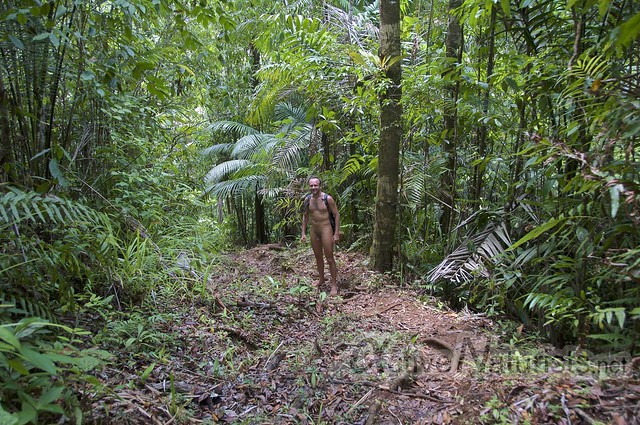
The next animal we spotted was a green parrot snake creeping up the tree (this was my first tree snake).
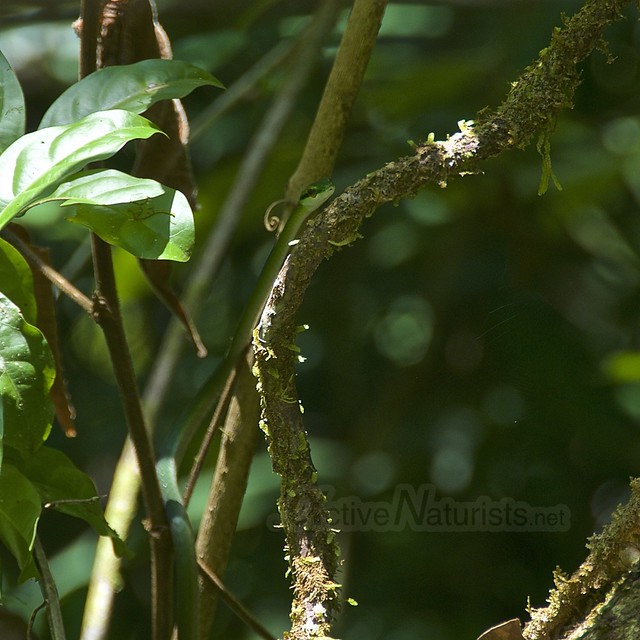
This plant creeper’s movement we wouldn’t be able to detect unless we used cameras over long time, but it was interesting to see how it was able to climb up the trunk vertically, with one type of the leaves attached to the trunk.

This lizard seemed to be quiet curious about us,

and it was posing well for the camera while climbing up the tree.
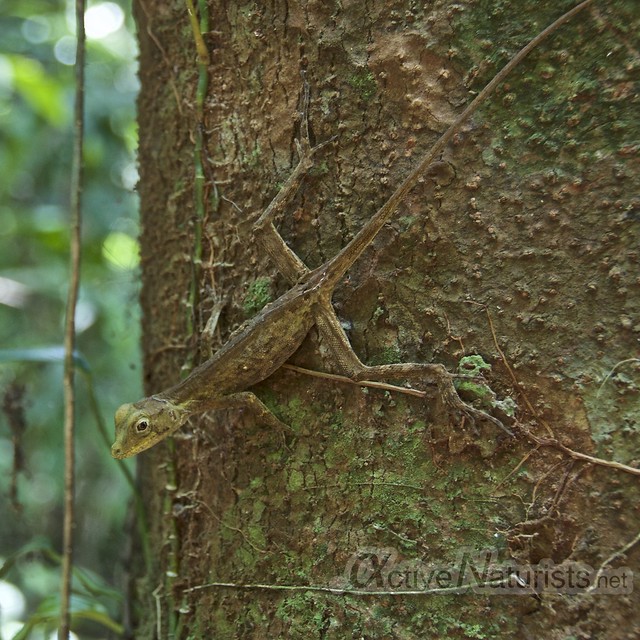
Meanwhile, another kind of lizard seemed to be a lot more timid and preferred to hide in the leaves on the ground.
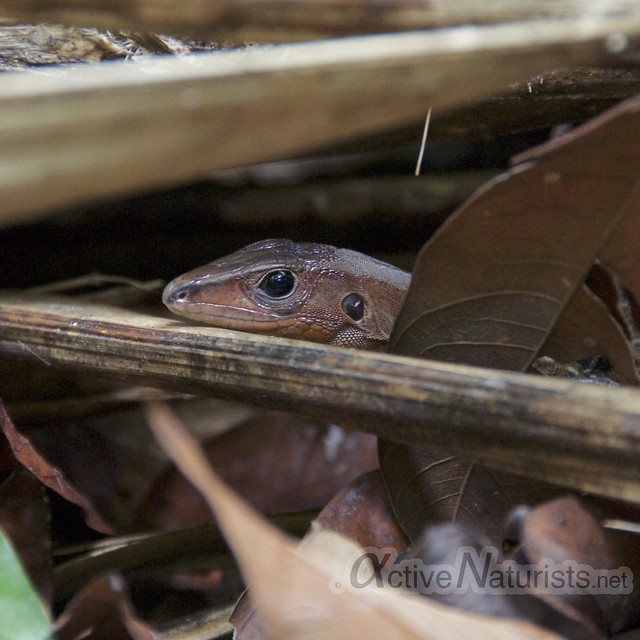
Then we saw plenty of animals of a specific kind that are not only not trying to hide but actually clear their path from dead leaves…
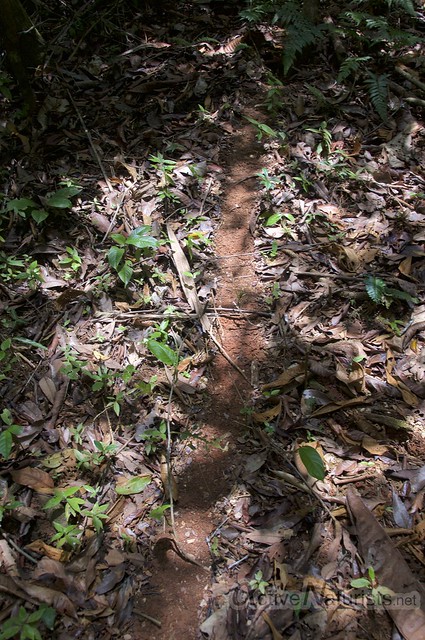
while carrying freshly cut leaf pieces towards their colony for mushroom farming.

It was interesting to see the work of leaf-cutter ants at different stages
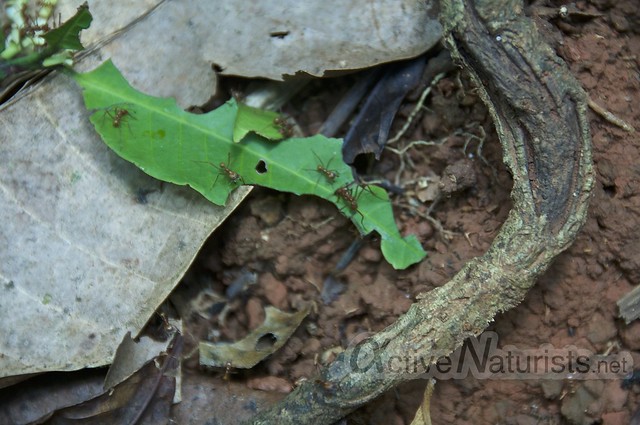
(though the final steps of mushroom farming are well hidden under ground).
There were probably many more insects that remained unnoticed, as most of them are well camouflaged

… unless they have outstanding pink eyes, like this grasshopper!
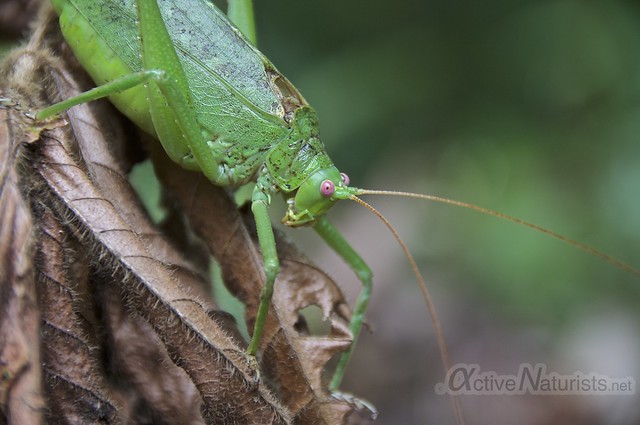
This shiny beetle didn’t bother to hide, but then it was quite well armored, as if made of metal.

After three hours of hiking, we crossed the first stream. It was shallow, but the water was clear and refreshing. It was full of small fish (also well camouflaged).
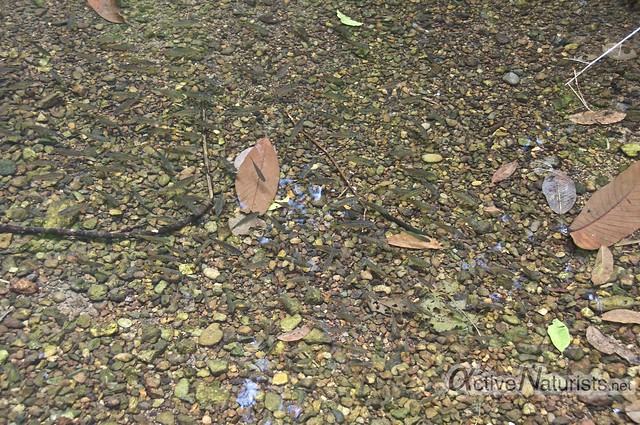
After walking in the dense forest, it was nice to be in a more open space,

and even nicer – to cool off in the stream (skinny-dipping, obviously).

Here we saw another lizard, the iconic basilisk, but only young individuals (nothing like the dragon at the Villa Roca hotel).
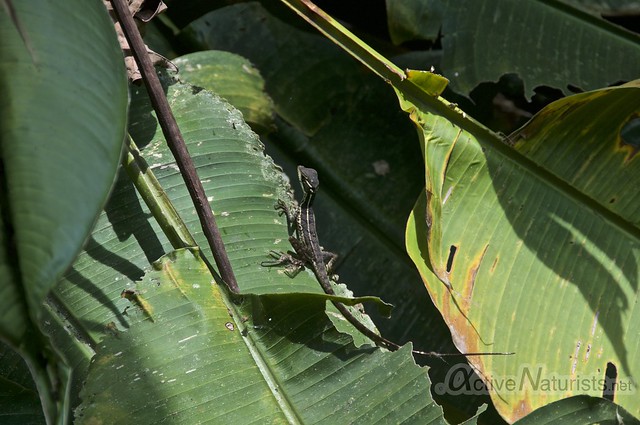
One of them was on the hunt for dragonflies,
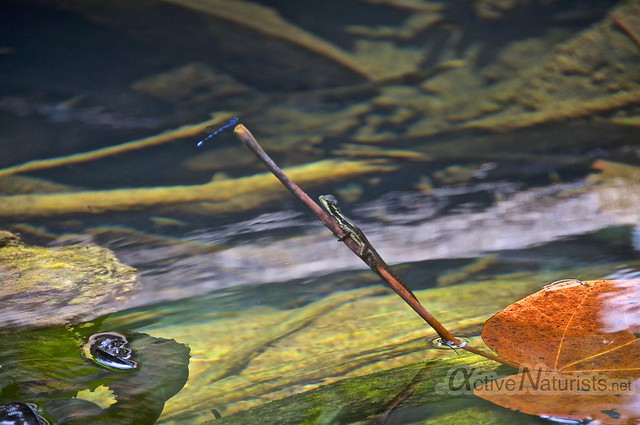
though not very successfully.
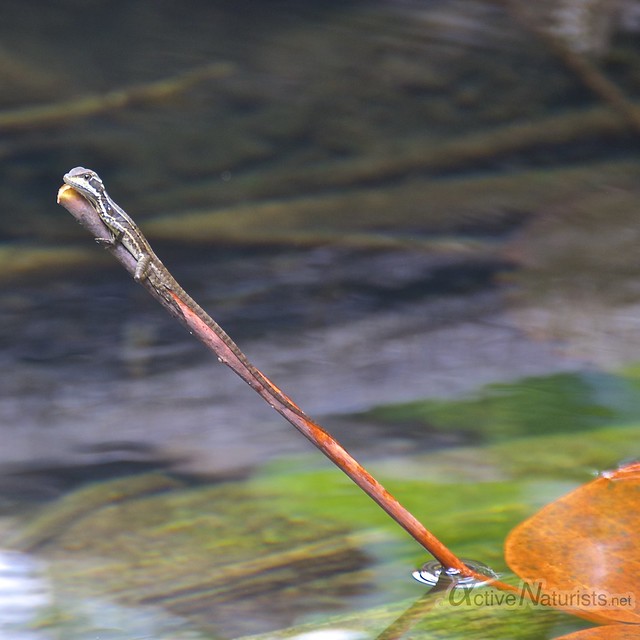
Not too far from the stream, we saw a blue-crowned motmot (similar to the one I saw by the cenotes in Yucatan).

Back in the forest, we were impressed again by the trees and their roots. Those intertwining roots may create cozy niches for other plants
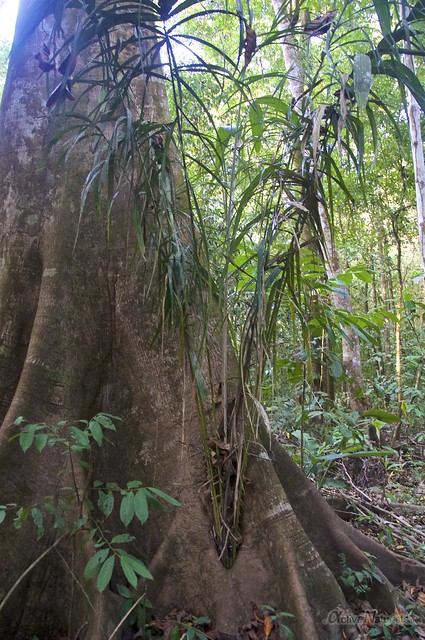
or anyone else willing to occupy them.
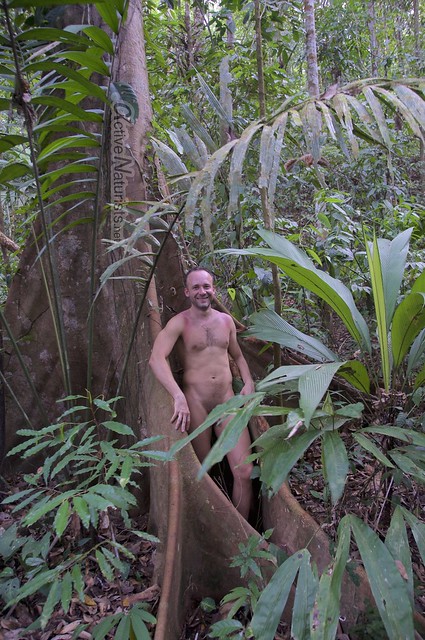
Some of those supporting, buttress roots were truly massive!
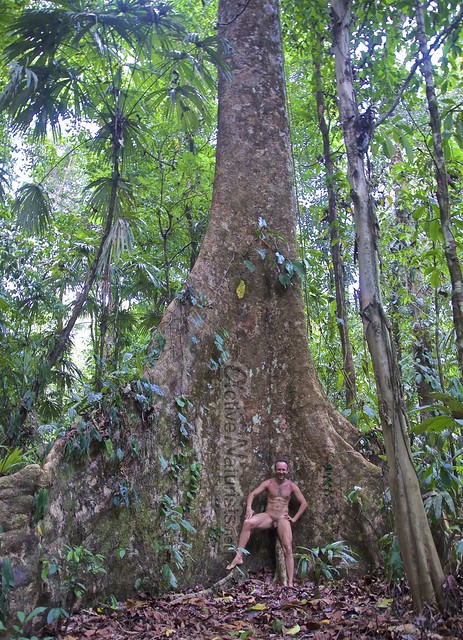
It’s worth noting, that to a large extent the roots wouldn’t be able to function without symbiosis with fungi, which do a lot of invisible job in the forest. We only notice them when they produce fruiting bodies for sexual reproduction, such as this purple mushroom.
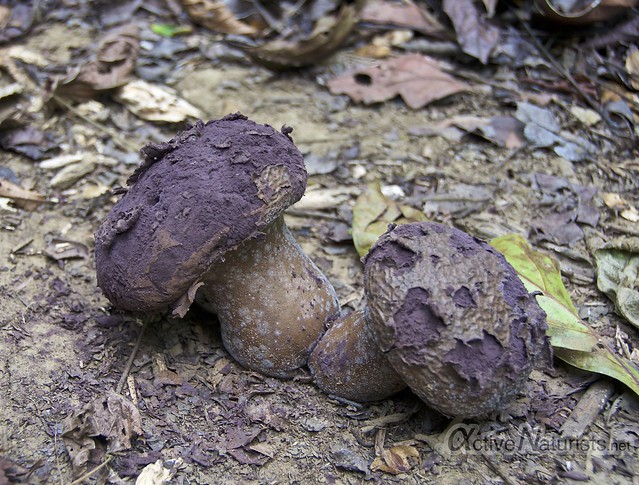
At another spot, the ground was covered in purple flowers.

This made us realize how much we were missing out by not being able to see the forest from the top. Quite a few of those trees must have been blooming, but the only way to see the flowers was when they would fall on the ground.
Besides the trees, lianas constitute a large and important part of plant life in the tropical forest,
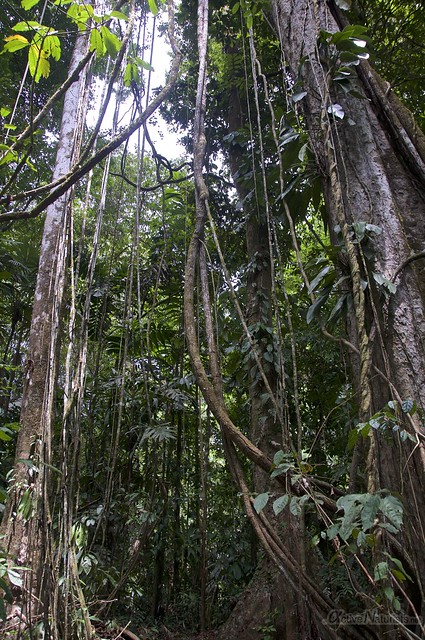
and we saw really massive lianas in Corcovado, as thick as trees. And some had to take peculiar forms on their way up (a U-turn?)
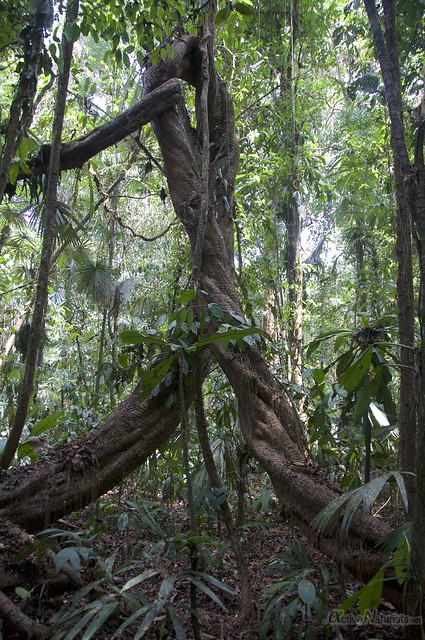
Many lianas interweave and twist their stems, and this one on the photo below reminded me the double helix of DNA.

Sometimes it was even hard to tell the border between neighboring trees, or where their roots ended and lianas began – as if they were all interconnected.
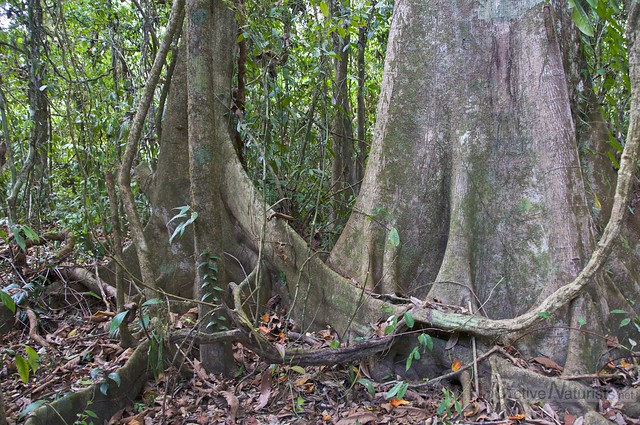
And of course there were plenty of tree-dwelling animals that like this kind of mess.

As we got across a big group of squirrel monkeys, it was amazing and amusing to see how easily they moved jumping between all those branches and lianas (on the photo above you can see how the tail is used for balancing).
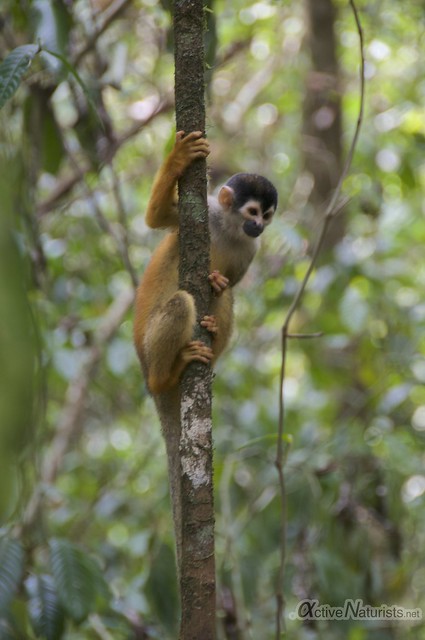
And they were equally good at using those brunches lounging =)
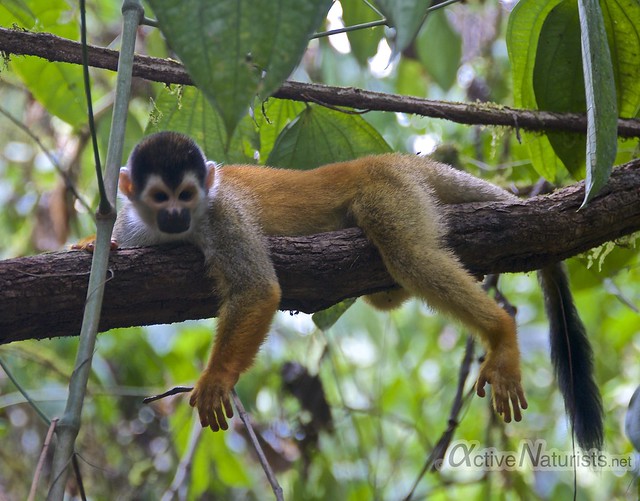
It was hard to tell who was more curious: monkeys about us, or we about them?

(Here you can see how the tail is used as a fifth limb.)
Though not all of them seemed that amused by the naked ape on the ground…

While we were goggling at our fast-moving tailed and furry relatives, Elias noticed another creature in the trees – a sloth!

It was sleeping (of course!) despite all the locomotion around.
The monkeys were in no rush to move away, and we could have spent much more time staring at each other, but we had to continue our trek.
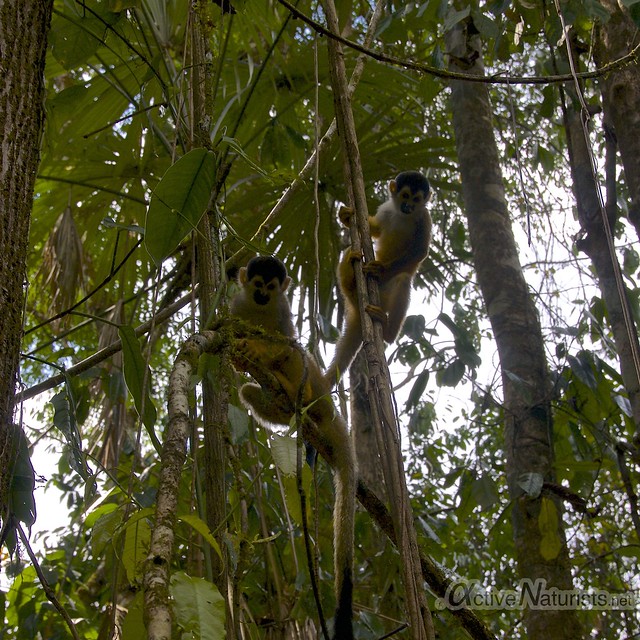
By that time, the forest became much drier (by rainforest standards), and flatter.
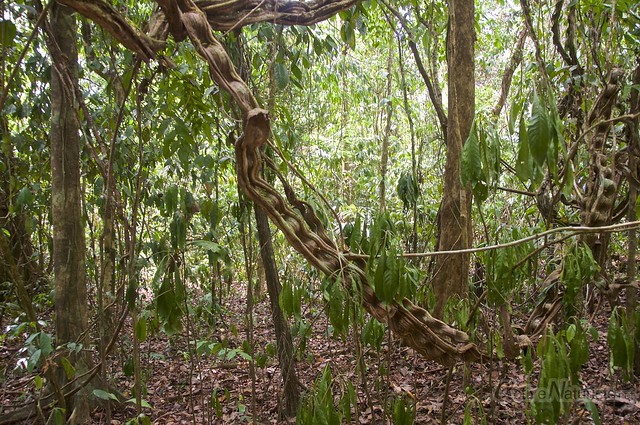
We passed through a grove of bamboos that were very tall but much thinner than typical species, but they were all intertwined and thus supported each other.
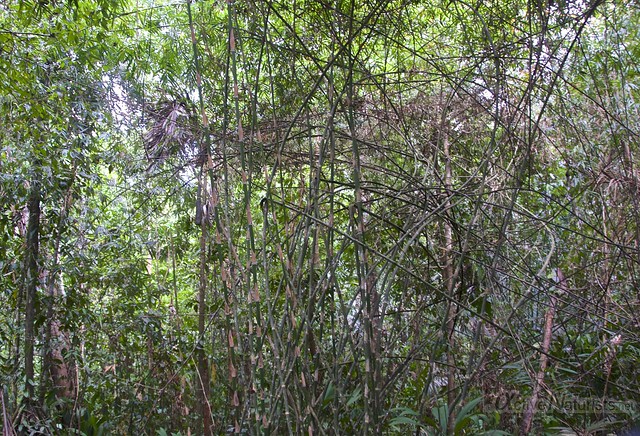
Although by then we had seen and heard plenty of parrots, they were all in a distance; so when we encountered a scarlet macaw feeding calmly in plain view, it was a beautiful and rare sight!

The next birdwatching opportunity presented itself shortly after and was equally exciting, though the bird wasn’t as bright except for the red face. It was quite excited about something too, as it announced its presence by piercing screeches (was it a warning for us?)
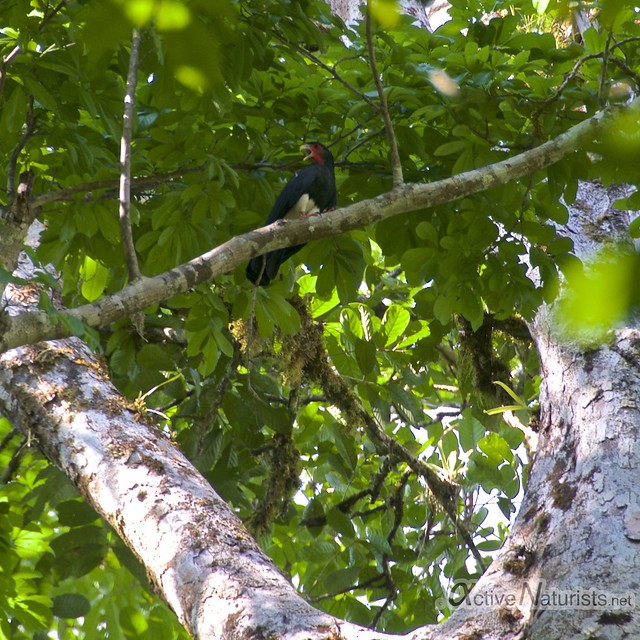
It was a bird of prey, caracara, but I cannot tell the exact species. It looks most similar to mountain caracara, but this species is not known on the Osa peninsula… any specialists among the readers here?
The afternoon was quite hot, so when we crossed another river, it felt very timely.
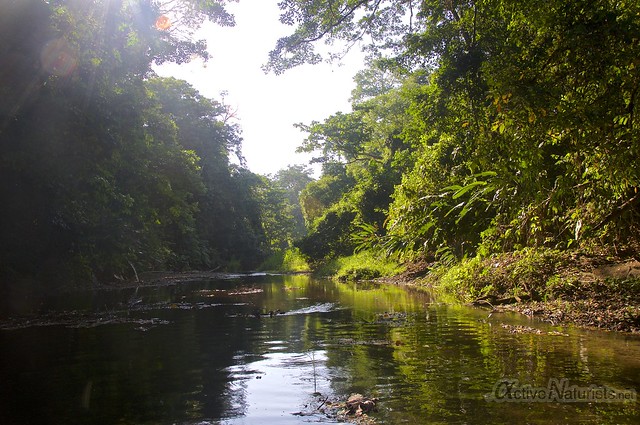
As the sun was setting, we had to continue to the campground at the Sirena biological station, but we were close already. That was when I realized I lost my shorts from the open pocket in the backpack! Unfortunately, the camp site is not clothing-optional here… but luckily one of my friends had a spare pair of briefs that looked like bicycle shorts.
At the approach to Sirena, we passed through a grove of fruiting pam trees with giant leaves.
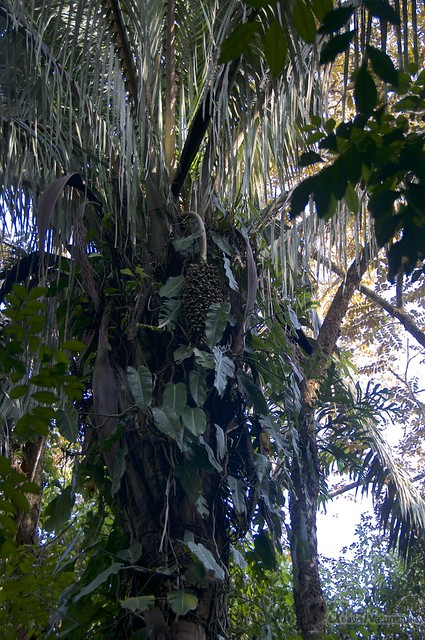
The last animal we saw on the trail that day was a quiet bird tinamou.
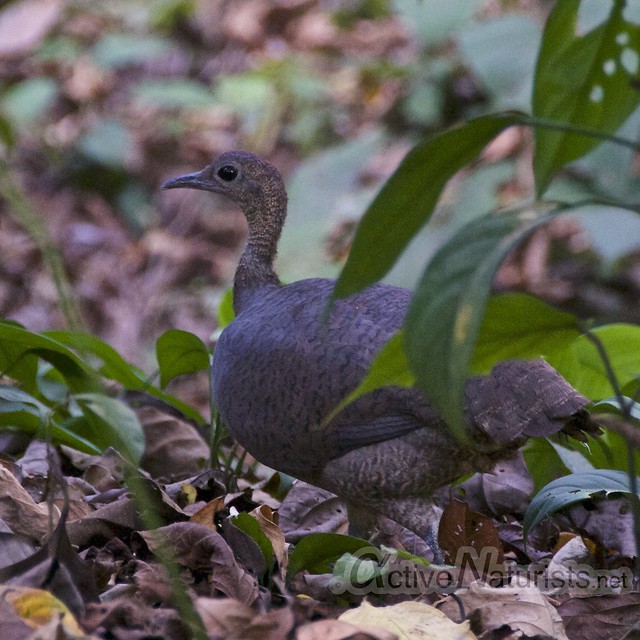
But that wasn’t it for the day. As we were setting up the tent at the campground, a tapir ventured out in the open!
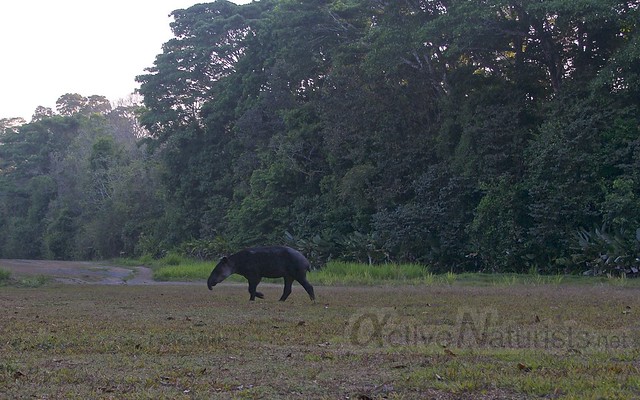
I was stunned – this was the largest animal I’d seen in the wild.
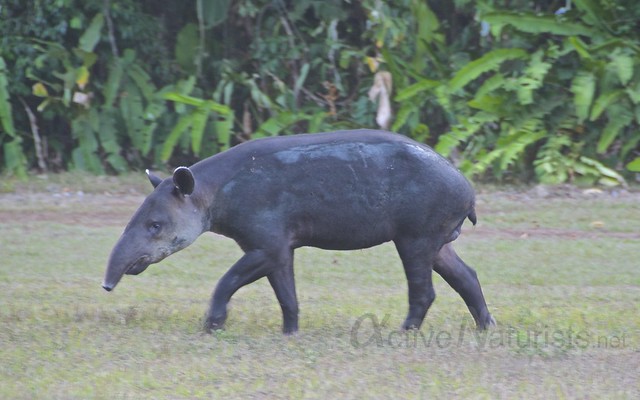
But the tapir himself couldn’t care less, was just passing the grassy area without much rush before disappearing in the forest again.

As it was getting dark, we went to the cafeteria for dinner, where I had to explain that my boxers were shorts – you know, they still want to keep some style for dinners even in the middle of the jungle 😀
At night we were enjoying our sleep despite the sounds of howler monkeys (which I first thought were jaguars!) and a thunderstorm. By the morning, everything was calm again. After breakfast, we ventured out to continue our trek.

Almost immediately after the station, the trail comes to the beach and it goes along the shore, but as I mentioned, this is a place where the beach and the forest meet – so here you can enjoy them both. The sand is mostly volcanic black, though not as pure black as at Kehena in Hawaii.
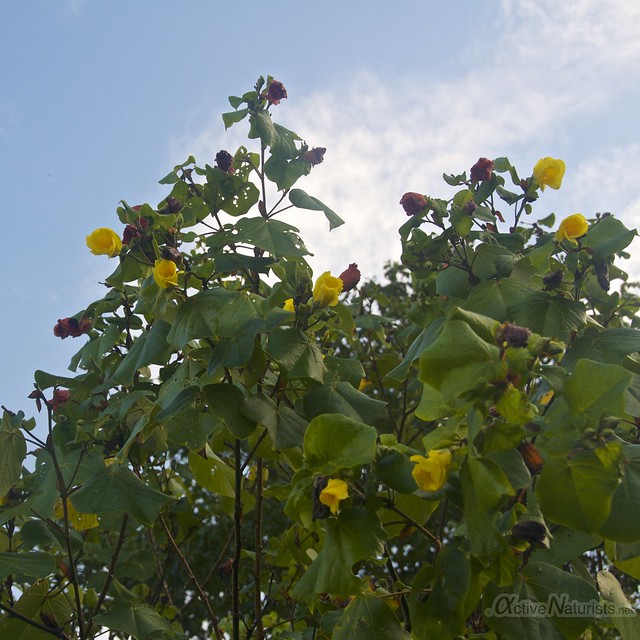
There was a tree with flowers that were either yellow or red, which seemed very unusual.

One possibility is that the color changes as the flowers mature, because the fresher ones tended to be yellow. Any other ideas?
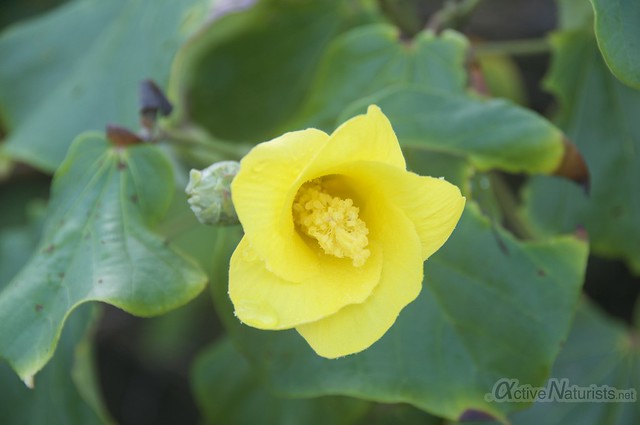
We had to cross quite a few river mouths, but they were all pretty shallow. I believe this may change quite a lot depending on rain and tide.

This explained why there were so many birds on the beach that are more typical for fresh water bodies,
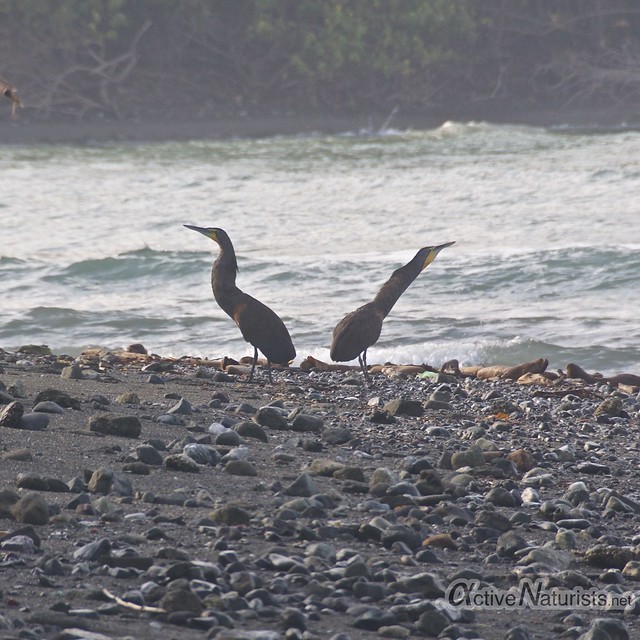
such as these bitterns.
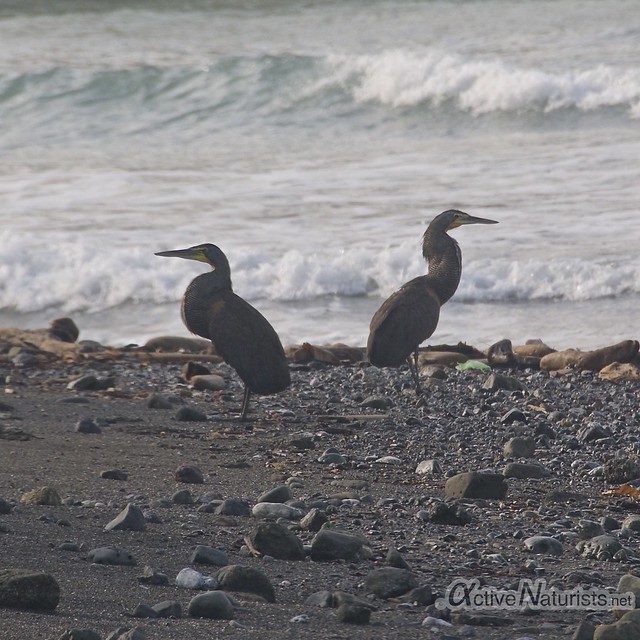
At the beach frontline, coconut palms were often the prevalent species; we passed through a few groves of those.

And the conditions seemed to be good for coconuts to germinate there. We also found a coconut that was full of juice, and our guide opened it for us using rocks and a regular knife. That a was perfect refreshment.

But here and there the trail would go deeper in the forest, with its giant trees and their intricate root systems.

Don’t be surprised if you see something like this golden orb-weaver spider on the web between those roots.

Though if you are lucky, you may see something prettier. You don’t see many orchids in the forest, because most of them grow higher in the trees.
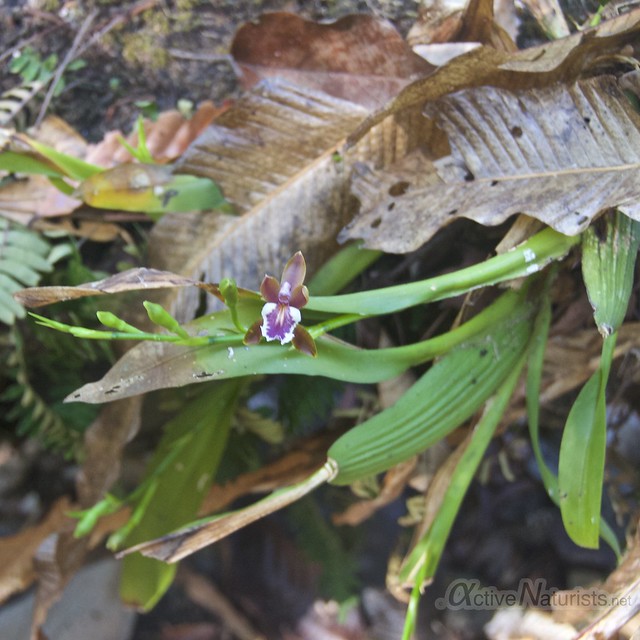
But here at the edge of the forest, even epiphyte orchids can grow closer to the ground, with more light available.
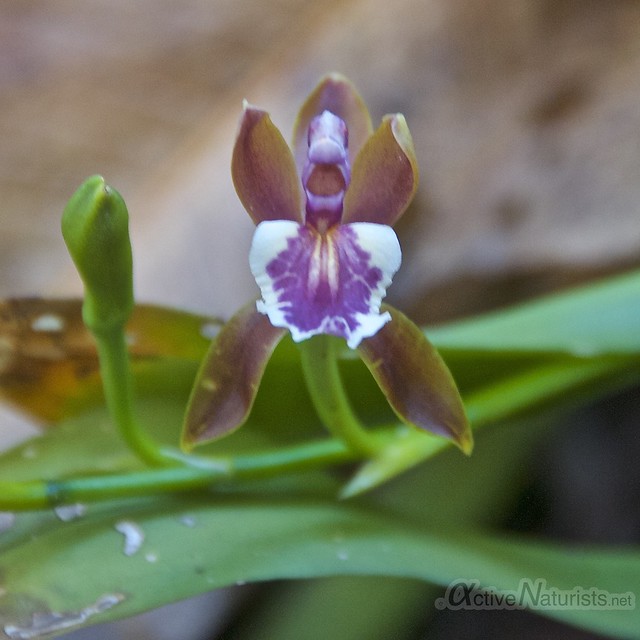
There must be a lot of competition between plants in this dense habitat which we don’t notice, unless it’s something more obvious like this menacing strangler fig getting a hold of another tree.
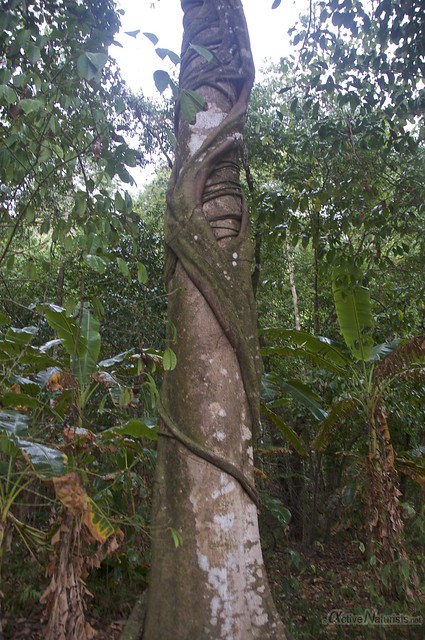
The amazingly intertwined lianas allowed me to stay suspended in the air, and I let my inner Tarzan out =)
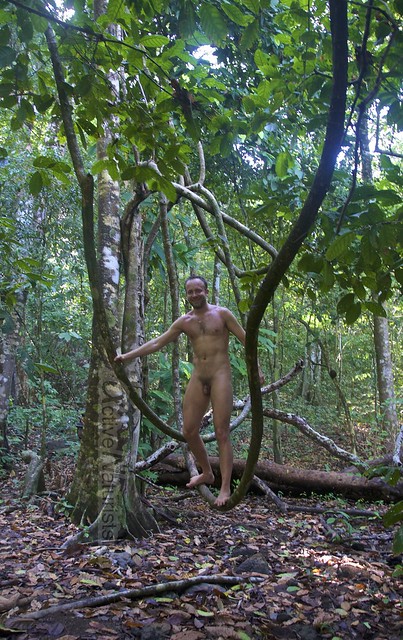
But this trail never went too far from the shoreline, so there was a refreshing breeze.

And on the beach, there was quite a lot of shade in the first half of the day.
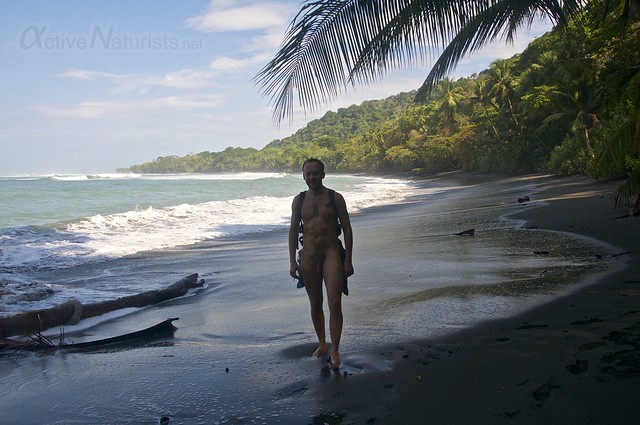
So overall, this section of our trek went a lot more leisurely; just once in a while we’d need go over or around the rocks.
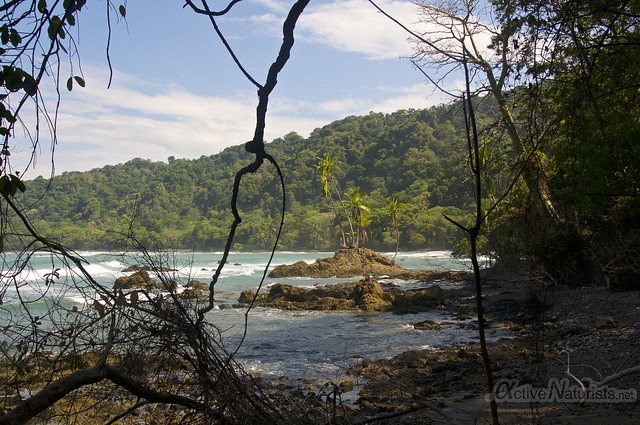
Even though it’s a rainforest, there are some trees here that are adapted for periods without much rain by accumulating water in their thick trunks. These are ceibas, and they can get very tall too.

And if you smack their trunks, you can here a ringing resound because of their hollow nature.
Ceibas have beautiful flowers, but we only found their leftovers with stamens.
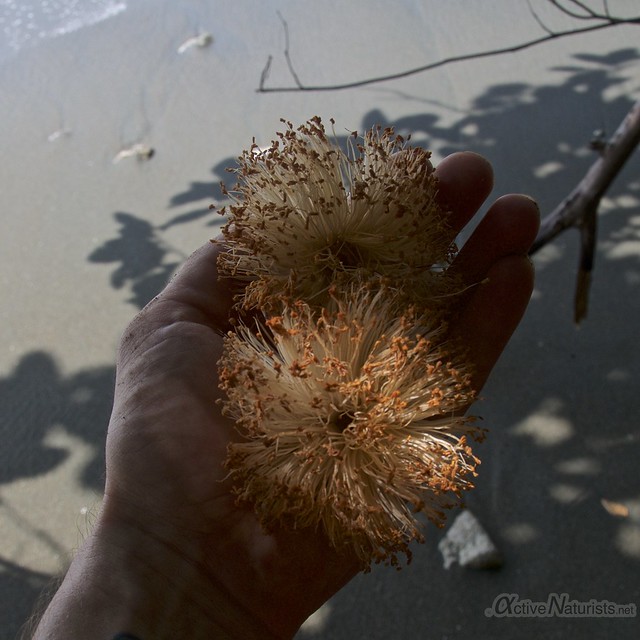
And there were more trees with impressive buttress roots.
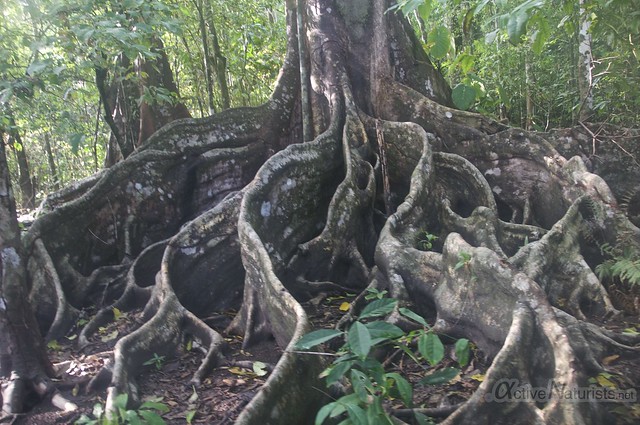
As we were approaching noontime, the sun was getting very strong, and there was less shade.
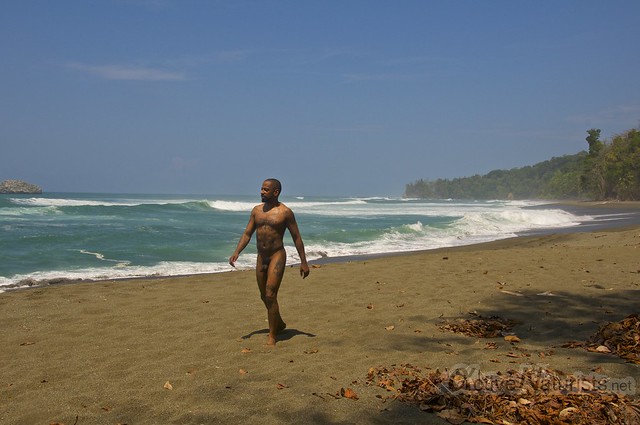
But we found a good spot to take a break, dip in the ocean and roll in the warm sand…

and climb a tree too.
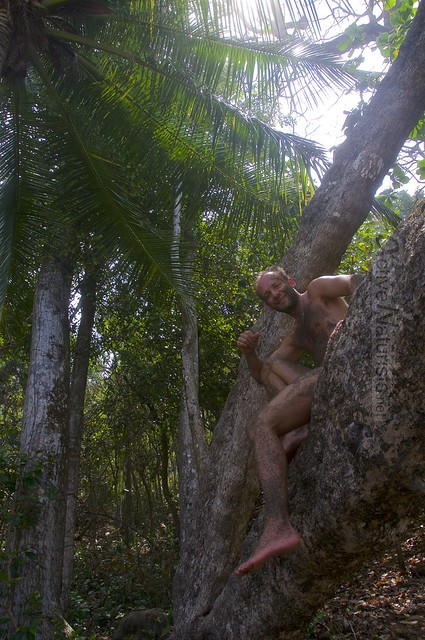
Then the weather changed rapidly, and we were afraid to get in a rainstorm, but it never got stronger than some drizzle.
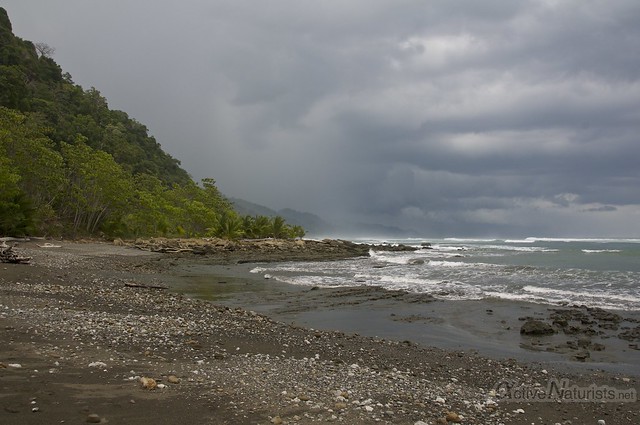
So far, that day wasn’t very rich on animal sightings, we could only hope to see something in the ocean – Costa Rica is a known whale-watching destination after all, but there was nothing to be seen in the water from the shore… Then, Elias pointed at a whale on the shore itself!
Well, it was a dead one…
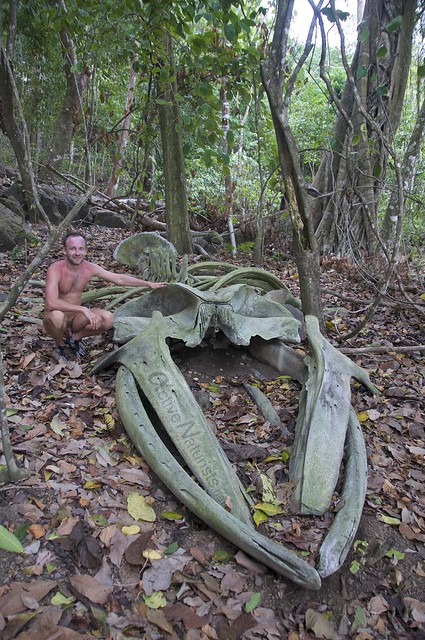
Very much dead indeed, but it’s as close as I’ve ever got to touching a whale. And we can only guess how it got this far in.
At the same spot, we saw a family of curious spider monkeys,

they might be wondering as to how we lost our fur 😀
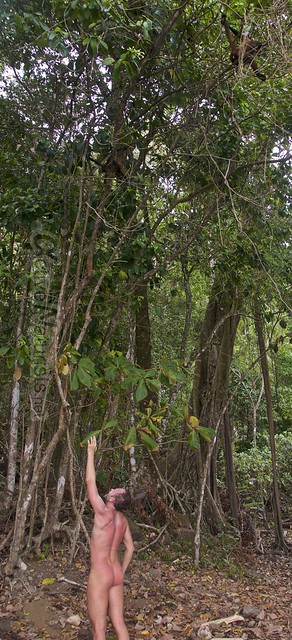
But it’d be fair to say, I felt like they were recognizing some family resemblance. Later, we saw a much bigger group of monkeys, but too high up in the trees to take photos. However, they also got interested in us, and were throwing fruit to us (and it didn’t seem like it was done in an aggressive manner). This reminded me of a recent story of a girl that was lost/abandoned in the jungle but survived at least partially thanks to the food that monkeys shared with her. Unfortunately, the mangos that were offered by the monkeys to us were not ripe at all except for one that was only barely edible.
Our next encounter was not so sociable, but I was very glad to be able to see it – an anteater. It was a northern tamandua, which is not a rare species, but still very elusive, especially during day time.
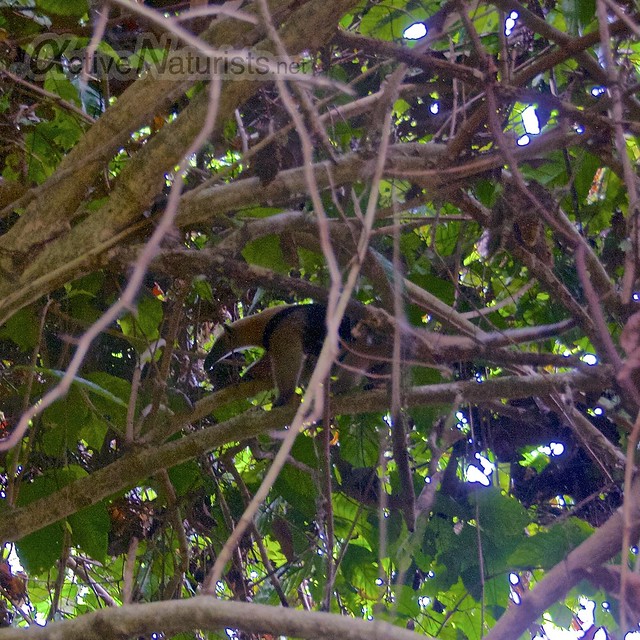
And it is quite an agile tree climber, using its tail as an additional limb.

We also saw two common black hawks.
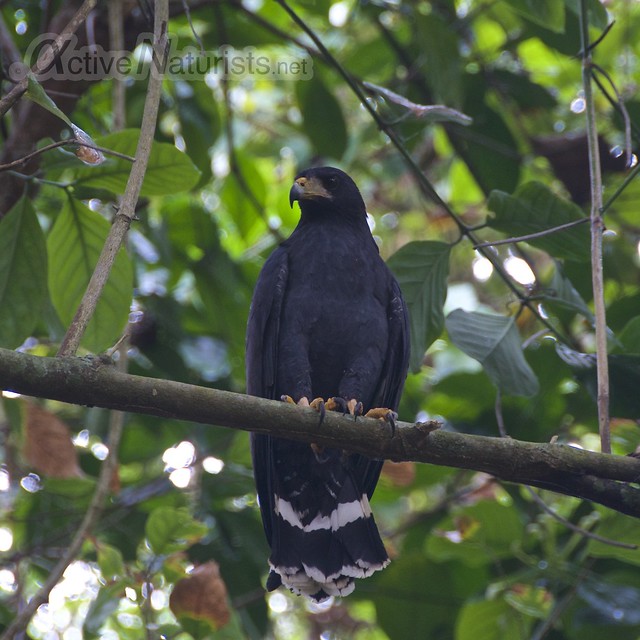
One of them was enjoying a meal.
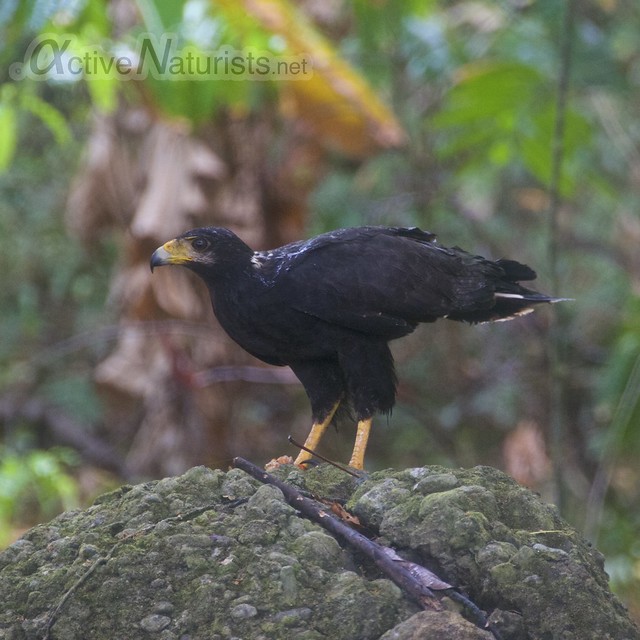
We saw a plenty of flying scarlet macaws again, which was a beautiful sight, but they moved too fast for taking photos.
Then we passed through a banana grove, to which we probably wouldn’t have paid much attention, if only to check if for any fruit to snack on (and there weren’t any ripe). But our guide called us to look under one of the leaves. And there was a group of bats! Only one of them stayed for the photos though.
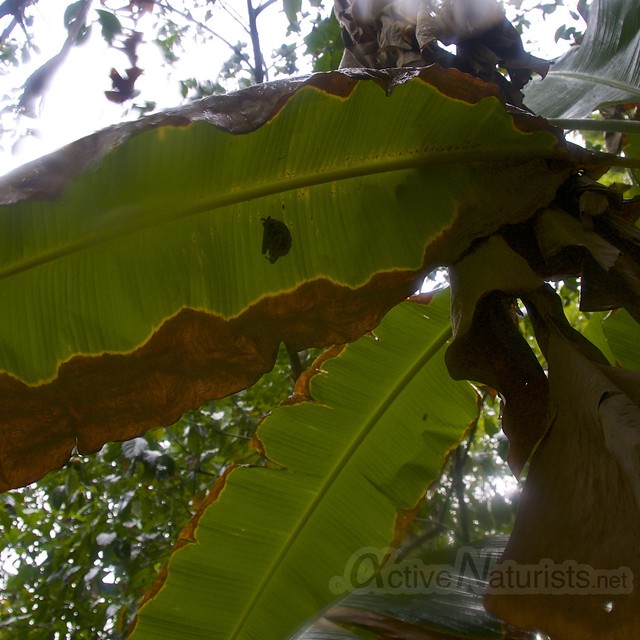
These are called tent-making bats, as they roost under big leaves which they bite in central section so that it folds as if roof of a tent.

And since they a frugivores, bananas can provide both food and shelter.
By the way, although most of the Corcovado National Park is a primary forest, some sections on the shore, where this trail passes, go through former plantations. I’ve already mentioned mangos and bananas, and they are not native species there. And even though Costa Rica is the largest producer of pineapples, those are not native either.
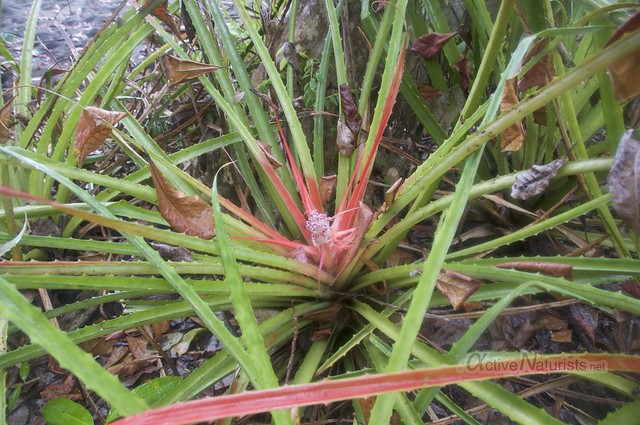
I assume this is a flowering pineapple plant, but it might be another bromeliad.
The last animal we saw by the trail before reaching La Leone ranger station was a coati.
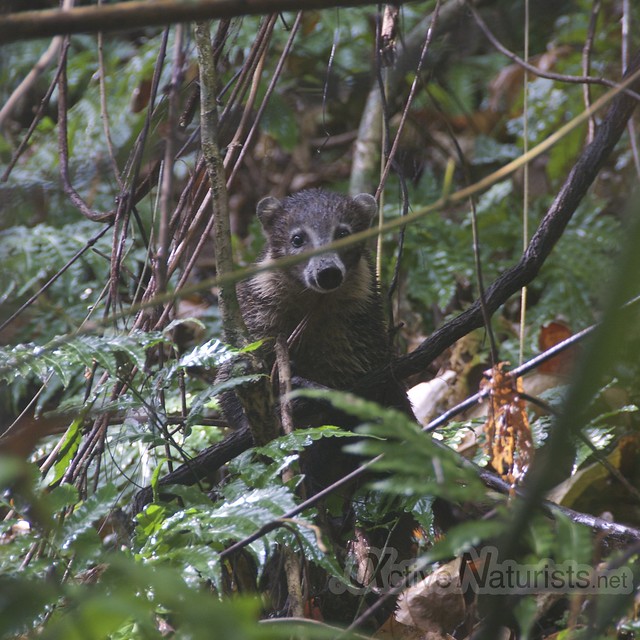
These relatives of raccoons are among the most ubiquitous mammals in Corcovado, and they usually live in groups, so it was ironic that we saw only one and by the end of our trek, after having seen plenty of more exotic animals.
After some rest at the ranger station (already clothed), we continued walking on the beach towards the nearest settlement – Carate. There, we had a nice dinner and a shower, and then camped on the beach (naked again).
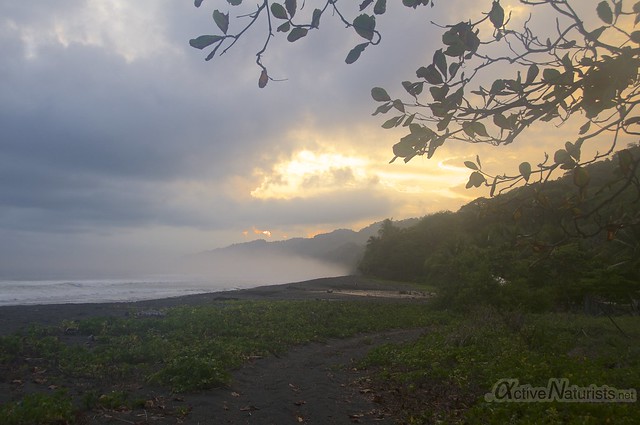
It was a pitch-black night, warm but with a breeze, and camping on sand was comfortable – all promised a good night sleep. But we didn’t realize that there were numerous crabs waiting to come out from their holes at night. And some of them happened to be under our tent. So if you camp on a beach like that, try to find a spot without any holes.
Next day, we planned to explore the forest along the river Rio Nuevo, but the car that was supposed to pick us up didn’t arrive, and there was no mobile phone service… Then someone came to let us know that the car broke on the way, so we had to take a bus to Puerto Jimenez.
Elias then organized another excursion for us in the afternoon. It was no longer within the park, actually next to cow pastures, but the prospect of skinny dipping in the river sounded good.

I found a fruiting monstera plant, and as I had tried this fruit for the first time just briefly before the trip and loved it (and it was very expensive at a NYC supermarket), I was eager to munch on this one in nature. Even its scientific name is Monstera deliciosa!
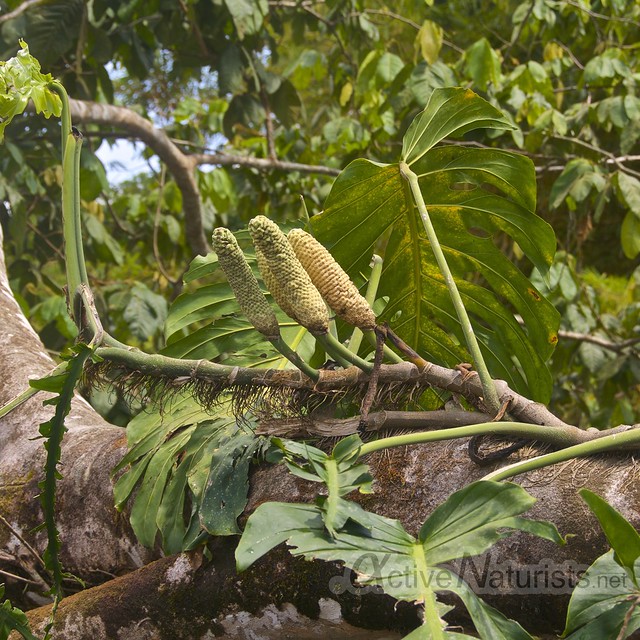
But unfortunately it wasn’t fully ripe, and it still had some irritating scales 😦
When I walked along the river, I saw a basilisk again.

And this time, I finally saw with my own eyes, why it is also called a Jesus lizard – it can walk on water! Well, not really walk but rather run –

and so fast, that you can hardly capture it with photography (unless you are well prepared for it).
I also saw a couple of tortoises in the river. But in a hole on the riverbank, there was another iconic reptile of the American tropics
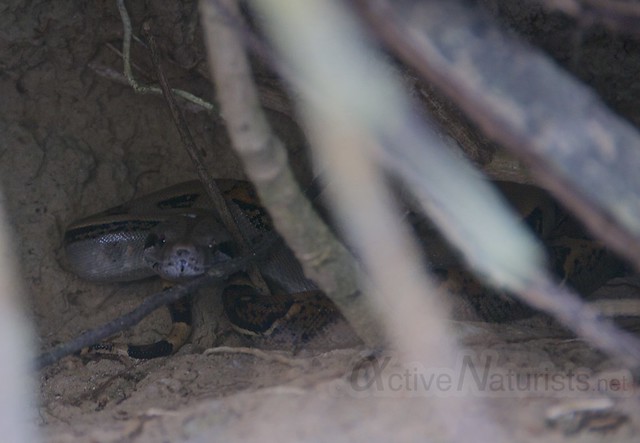
– a boa constrictor. Unlike with the basilisk, I didn’t see it in action. I actually noticed a few ticks attached to it – so instead of a boa constrictor sucking life out of its prey, I saw those small arachnids sucking on its blood.

So much wildlife in so many forms we saw in those 3 days in Corcovado National Park and its surroundings, it’s amazing! If you are a nature enthusiast, it is certainly a top destination. Hopefully, you’ll have a good guide too. And in case you lose your shorts, you may find mine somewhere on the trail 😉































 The retreat is set on the Wollondilly River and it’s beautiful in a very typically Australian Bush kind of way.You can walk for several kilometres and follow some 4 wheel drive tracks, swim in the river or enjoy the pool, all nude if you like.
The retreat is set on the Wollondilly River and it’s beautiful in a very typically Australian Bush kind of way.You can walk for several kilometres and follow some 4 wheel drive tracks, swim in the river or enjoy the pool, all nude if you like.







